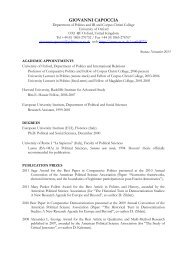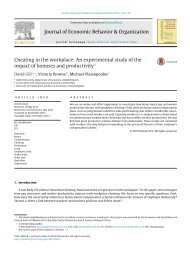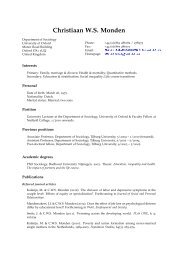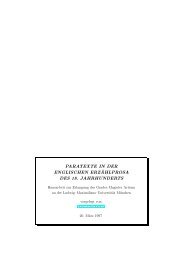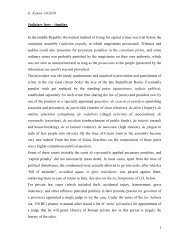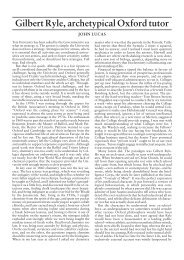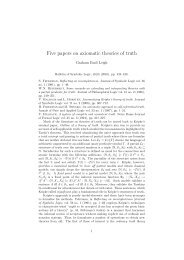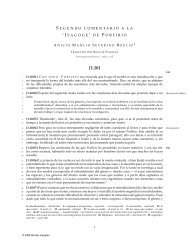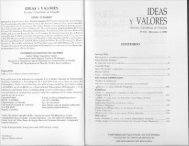Lexical Functional Grammar - Personal Pages Index
Lexical Functional Grammar - Personal Pages Index
Lexical Functional Grammar - Personal Pages Index
Create successful ePaper yourself
Turn your PDF publications into a flip-book with our unique Google optimized e-Paper software.
(45) Thematic hierarchy (Bresnan & Kanerva, 1989):<br />
AGENT > BENEFACTIVE > RECIPIENT/EXPERIENCER<br />
> INSTRUMENT > THEME/PATIENT > LOCATIVE<br />
One of the default mapping rules requires the argument of a predicate that is<br />
highest on the thematic hierarchy to be classified as unrestricted (−R). For<br />
example, if a verb requires an AGENT argument and a PATIENT argument, the<br />
AGENT argument thematically outranks the PATIENT argument, and thus the<br />
AGENT argument is classified as unrestricted.<br />
For a predicate with an AGENT and a PATIENT argument, like kick, this<br />
has the following result (Bresnan & Kanerva, 1989):<br />
(46) kick 〈 AGENT PATIENT 〉<br />
intrinsic: [−O] [−R]<br />
defaults:<br />
[−R]<br />
SUBJ SUBJ/OBJ<br />
Final classification: SUBJ OBJ<br />
For simplicity, we will consider only the intrinsically unrestricted classification<br />
of the PATIENT argument, leaving aside the option to consider the PATIENT<br />
an intrinsically objective function. The AGENT argument is classified as intrinsically<br />
nonobjective. The default rules add the unrestricted classification to the<br />
thematically highest argument, the AGENT. Since the AGENT is classified as<br />
[−O,−R], it is the SUBJ. The unrestricted classification of the PATIENT argument<br />
allows it to bear either the SUBJ or the OBJ role, but since the AGENT<br />
is assigned the SUBJ role, the PATIENT must be realized as OBJ. Thus, the<br />
argument classification rules, together with well-formedness conditions like the<br />
Subject Condition requiring each verbal predicate to have a subject, constrain<br />
the mapping between argument roles and grammatical functions.<br />
5.2 Glue: The syntax-semantics interface<br />
LFG assumes that the syntactic level that is primarily involved in semantic<br />
composition is the functional structure. That is, functional relations like SUBJ<br />
and OBJ rather than c-structure tree configurations are primarily responsible<br />
for determining how the meanings of the parts of a sentence combine to produce<br />
the full meaning of the sentence.<br />
The dominant theory of the syntax-semantics interface in LFG is the socalled<br />
glue approach (Dalrymple, 1999, 2001), a theory of how syntax guides<br />
the process of semantic composition. The glue approach assumes that each<br />
part of the f-structure corresponds to a semantic resource associated with a<br />
meaning, and that the meaning of an f-structure is obtained by assembling<br />
the meanings of its parts according to a set of instructions specifying how the<br />
semantic resources can combine. These assembly instructions are provided as a<br />
set of logical premisesin the “glue language” of linear logic, and thederivation<br />
of a meaning for a sentence corresponds to a logical deduction.<br />
19



